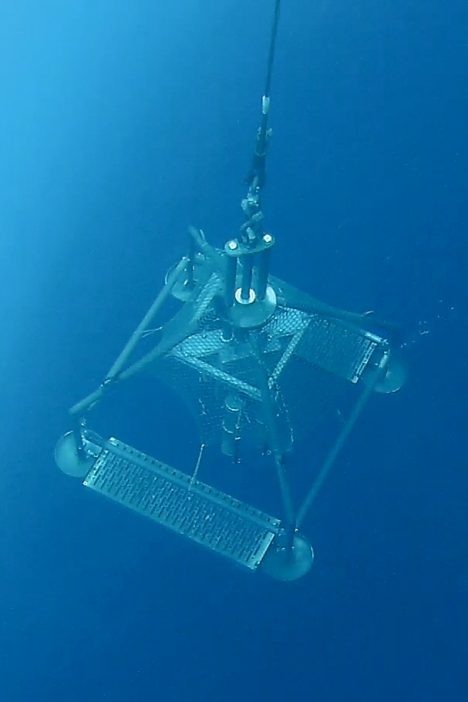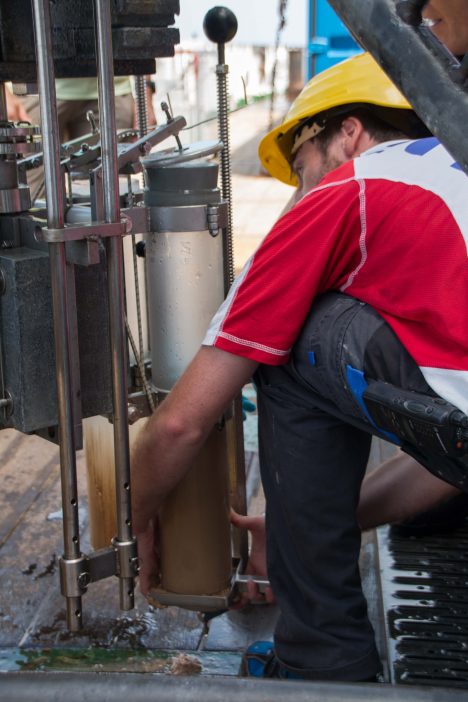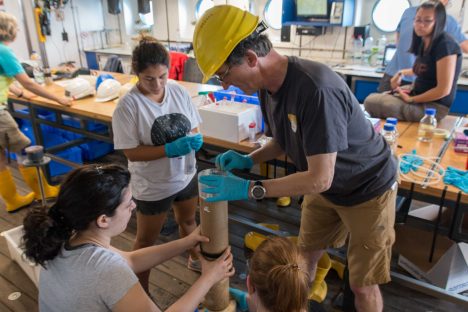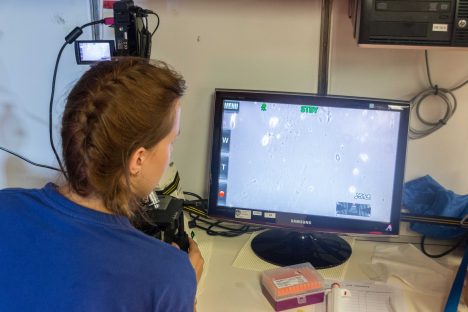Dear interested reader, colleagues, friends and families,
we arrived at the first sampling station in the territorial waters of the Dominican Republic in the Caribbean Sea. During 60 hours of team work, we took water and sediment samples across 4000 m depth using three different systems: Water samples were taken from multiple water depths with the help of the CTD (conductivity-temperature-depth) – rosette sampler and the ISMI (in situ microbial incubator) system. In addition, deep-sea sediment was taken by means of the MUC (multicorer) system. As you can read about our test run of the MUC system, we practised to handle the valuable sediment cores beforehand. This time, we were happy to see the first sediment cores from 4050 m depth (!) appearing at the surface (Image 1), even though not all cores contained sediment. Immediately after the salvage of the MUC system (Image 2), the cores were carefully taken from the scaffold (Image 3) and brought inside the laboratory (Image 4). The overlaying water was pumped into culture bottles, the upper two millimetres of sediment were directly screened under the microscope (Image 5) and some centimetres of sediment were frozen for further analysis in Cologne. Life is not evenly distributed in the deep sea. The number of individuals and the species richness declines depending on the depth. We were very lucky to find living ciliates (the first living ciliate ever seen alive collected from deep-sea sediments from a depth below 2000 m), flagellates and nematodes in the surface of the sediment. The accumulation rates of sediment are very low, only a few centimetres per thousand years. Thus, the sediment cores in our hands carry the oceanic history of many thousand years.
Your M139 team
–
Liebe interessierte Leser, Kollegen, Freunde und liebe Familien,
wir sind an der ersten Station für Beprobungen in den Hoheitsgewässern der Dominikanischen Republik in der Karibik angekommen. Innerhalb von 60 Stunden Team-Arbeit haben wir Wasser- und Sedimentproben mithilfe von drei verschiedenen Systemen über eine Tiefenskala von 4000 Metern genommen: Mehrere Wasserschichten wurden mit dem CTD-Kranzwasserschöpfer (z. Dt. Leitfähigkeit, Temperatur, Tiefe) und dem ISMI-System (z. Dt. In situ – Mikrobeninkubator) isoliert und Tiefensediment wurden mit dem MUC-System (z. Dt. Multikern) genommen. Wie Sie in einem früheren Blog über den MUC-Trockenlauf lesen können, haben wir den Umgang mit den wertvollen Bohrkernen vorher geübt. Dieses Mal waren wir glücklich, die ersten Sedimentkerne aus 4050 m Tiefe (!) an der Oberfläche erscheinen zu sehen (Bild 1), obwohl nicht alle Kerne befüllt waren. Sofort nachdem das MUC-System geborgen wurde (Bild 2), konnten die befüllten Kerne vorsichtig aus dem Gerüst gehoben (Bild 3) und in das Labor gebracht werden (Bild 4). Das Überstandswasser wurde in Kulturflaschen gefüllt, die oberen zwei Millimeter des Sediments wurden direkt unter den Mikroskopen ausgewertet (Bild 5) und weitere Sedimentproben wurden für spätere Analysen in Köln eingefroren. Das Leben in der Tiefsee ist nicht gleichmäßig verteilt. Die Individuenzahlen und der Artenreichtum nehmen in Abhängigkeit von der Tiefe ab. Daher hatten wir großes Glück, lebende Ciliaten (die ersten je lebend aus Tiefen von mehr als 2000 m geborgenen), lebende Flagellaten und Nematoden in Proben von der Sedimentoberfläche zu finden. Das Untersuchungsgebiet akkumuliert Sediment mit einer sehr niedrigen Rate von nur wenigen Zentimetern pro tausend Jahre. Daher sind die Bohrkerne in unseren Händen viele Tausend Jahre alt.
Ihr M139-Team

Image 1 | The MUC system in the blue appearing from 4050 m depth. (Photo obtained from an action camera by Johannes Werner)

Image 2 | The MUC system with two usable cores is brought on bord. (Photo: Johannes Werner)

Image 3 | The sediment cores in the scaffold of the MUC system. (Photo: Johannes Werner)

Image 4 | Both ends of the core have to be plugged carefully and quickly. (Photo: Johannes Werner)

Image 4 | The sediment surface is isolated in the wet laboratory. (Photo: Johannes Werner)

Image 5 | The suspended sediment surface is screened under the microscope. (Photo: Johannes Werner)
Herzlichen Glückwunsch zu dem gelungenen “Tiefseefang”.
Wir haben Euch die Daumen gedrückt.
Herzliche Grüße aus Comillas von der Atlantik- Küste (Nord-Spanien)
Norbert und Christiane Ahlers